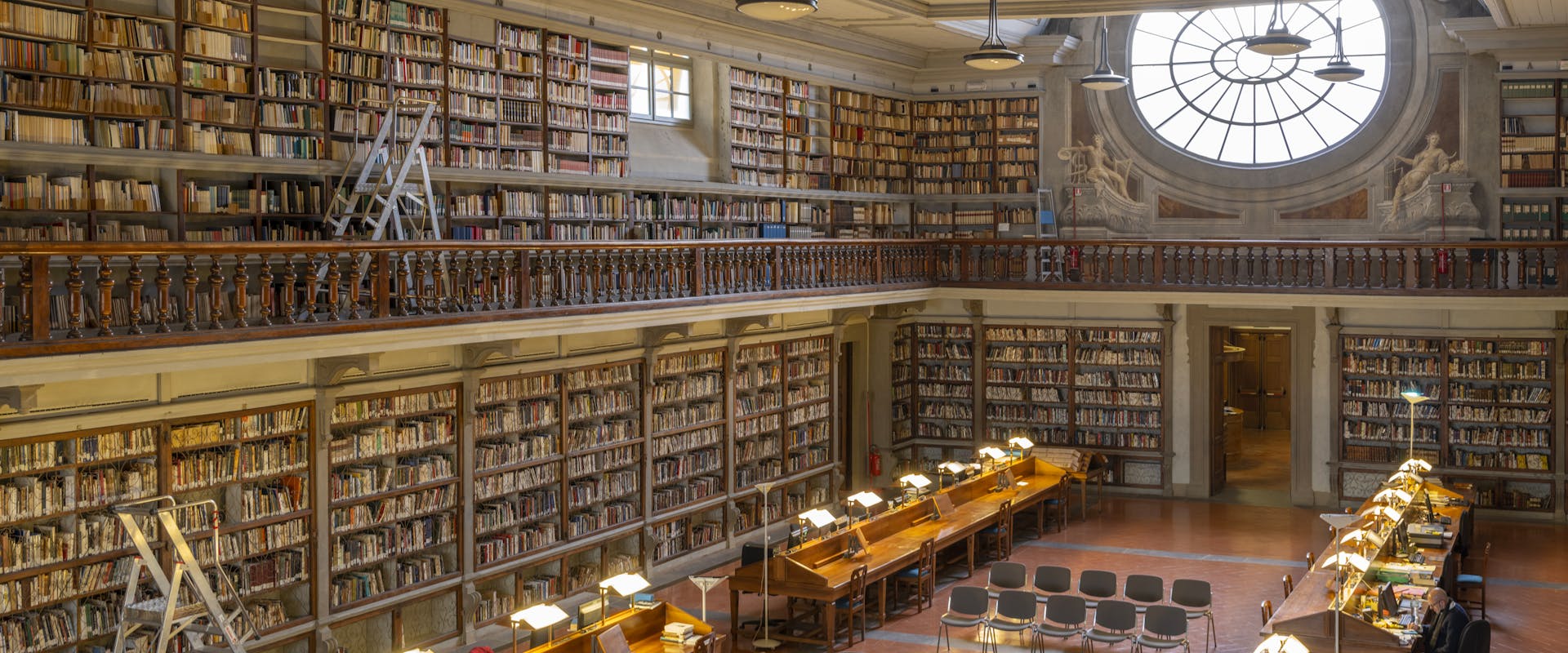Uffizi Library
OPENING HOURS FOR USERS
Tuesday (9am-5pm)
Wednesday (9am-1pm)
Thursday (9am-1pm)
Be sure that the Library is open or the opening hours are still valid by checking this link.
HOW TO ACCESS THE LIBRARY AND REGULATIONS
Access to the Library is restricted to those who request to consult the bibliographic and documentary holdings stored there according to the hours and days indicated above. It is necessary to pass through the metal detector located at the entrance of the Uffizi (on the eastern side of the Loggia). Then ask the staff in charge to be directed towards the Library (avoiding to wait in the line along with the visitors directed to the museum). As to the rules of behaviour and consultation, please read the attachments below carefully.
DOCUMENTS TO DOWNLOAD
See below the attached files for editable docs concerning Purchase Proposal, Questionnaire, Complaint Form, and here Privacy statement.
CONTACTS
ga-uff.biblioteca@cultura.gov.it
Catalogue
The catalogue has been digitalised since 1996 in the Iris database.
Iris is an inter-library association comprising: the Berenson Library of Villa I Tatti, the Library of the Fondazione Roberto Longhi, the Library of the Netherlands Institute for Art History, the Library of the Opificio delle Pietre Dure (Workshop of semi-precious stones), the Library of the Istituto Nazionale di Studi sul Rinascimento (National Institute for Renaissance Studies) and the Library of the International University of Art.
According to the latest estimate of June 30, 2003 the bibliographic records of the Uffizi Library entered in the IRIS database amounted to 40,000. The digitalisation of the remaining 23,000 items is ongoing.
The Iris database can be consulted online here.
Fondo Carocci
Available online, the Fondo Carocci (Carocci Archive) of the Uffizi Library provides fundamental information about Medieval Florence before the renovation that took place in the city centre at the end of the 19thcentury.
ABOUT THE COLLECTIONS
To fully experience and understand the Uffizi Library (formerly the Magliabechiana Library) and its elegant environment, one must first consider Antonio Magliabechi, whose stern bust dominates the back of the room. Antonio Magliabechi (Florence 1633-1714) was an Italian scholar, academic and librarian to the Grand Duchy of Tuscany at the time of the Medici. Cosimo III entrusted him with the task of overseeing the Medici’s Palatine Library in the Pitti Palace, and he wrote a vast catalog detailing the library of Cardinal Leopoldo de’ Medici. He also looked after the library of Grand Prince Ferdinand, compiled at the end of the seventeenth century.
Upon his death, Magliabechi left behind a legacy of around 30,000 handwritten and printed volumes, spread across his home in Via della Scala and the Palazzo Vecchio. His donation led to the foundation of Florence's first public library, the first seed of today's National Central Library. To organize the volumes, the executors of his will, Marmi and Comparini, who were the collection’s first librarians, rented an old theater, the “Teatro degli Istrioni”, at the Uffizi, then owned by the Florence Customs Department and known in the sixteenth century as the Teatrino della “Baldracca” after the notorious city quarter of taverns and brothels where actors of the Commedia dell’Arte would perform popular shows. During the most recent restoration, a series of frescos celebrating ethics and culture (such as Knowledge overcoming Lust) and lamenting the former use of the building were rediscovered, as demonstrated by the inscription on the cartouche in the reading room: QUIDNI DICARIS/STUDIORUM APPETENS LITERARUMQUE CULTRIX/ FLORENTIA/THEATRUM IAMDIU HISTRIONIA ET RISUI DICATUM/NUNC MELIORE FATO CONVERSUM EST/IN PUBLICUM DOMICILIUM ERUDITIONIS/ATQUE MUSARUM (Why, O Florence, could you not be said to be longing for learning and a lover of words, you who for so long have been the scene of comedy and devoted to laughter and now transformed by the greatest of fates into the public home of Erudition and Poetry?)
The refurbishment of the room and its decoration were entrusted to the meticulous care of artist and architect of the Medici court, Giovanni Battista Foggini. Throughout the furnishing of the Library and the preparation for its opening to the public, Grand Duke Gian Gastone de’ Medici played a leading role, acting to ensure that the legal printing and storage rights for books from all the typographers across Florence were held by the Magliabechiana Library. Finally, on the first Tuesday of 1747, during the reign of Francis I Stefano di Lorena, the Magliabechiana Library was opened to the public, becoming an important meeting point for Florentine academics and the most illustrious Italian and foreign scholars for over two centuries.
Following the unification of Italy, in 1885 the Magliabechiana Library was renamed the National Central Library. Fifty years later, in 1935 every single volume was transferred to the new site of the National Central Library of Florence in Piazza Cavalleggeri. On December 1998, the Uffizi Library took up residence in the eighteenth-century hall of the former Magliabechiana Library. Today the Library is a precious source of information on the history of the Uffizi and the Florentine Galleries: it houses the inventories of the Tribuna Room from 1589 to 1890, letters from artists, Directors and antique dealers, historical guides, artist biographies, catalogs of exhibitions and museums from around the world, as well as important documents essential to the understanding of the histories and origins of the assets of the museums' collections.
